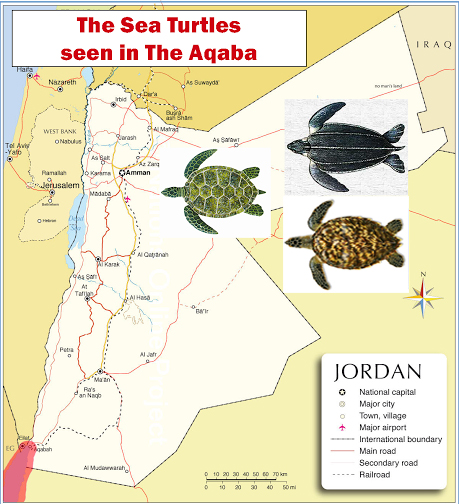Species-in-Jordan
 SEA TURTLES
SEA TURTLES
The Jordanian coast of the Gulf of Aqaba hosts three species of marine turtles: the Hawksbill Turtle (Eretmochelys imbricata), The Green Turtle (Chelonia mydas) and the Leatherback Turtle (Dermochelys coriacea).
None of these species nests on the Jordanian coast as a result of the absence of nesting grounds, but there are rich localized pastures in the Gulf of Aqaba, all specimens seen, photographed or collected are almost mature and none of them is newly hatched. Accordingly specimens collected on the Jordanian coast may be considered waifs. It was reported on (1982) the occurrence of four marine turtles: Caretta caretta, Chelonia mydas, Eretmochelys imbricata and Dermochelys coriacea from Sinaitic Red Sea shores without giving any locality. Despite that turtles are fully protected along the Jordanian coasts, still oil spells from tankers is a common problem.
Family Cheloniidea
Several specimens of Eretmochelys imbricata were kept at the Marine Science Station, Aqaba. One immature taxidermized specimen is in the collection of JUM-Amman (56 cm carapace length) and was captured in Aqaba in December 1991. A mature specimen was photographed in front of the Marine Science Station in December 1996.
Souvenirs of this species were seen in shops in Aqaba and all shells were more than 50 cm in length. It was reported on capturing two immature specimens at Nuweiba in December 1975, this is the most common species in the Gulf of Aqaba, and maybe the most abundant species in the entire Red Sea. During the present investigation, Chelonia mydas was seen, photographed and captured in the Gulf of Aqaba, mainly in December and January. Moreover, their occurrence in the Red Sea proper is more common, it was reported in (1984) that E. imbricata is known as a dweller of tropical coral reefs and feeds on soft-bodied prey (sponges and soft corals). The Jordanian coast of the Gulf of Aqaba is well known for its richness in coral reefs, which may furnish suitable feeding habitat for this species. Incidental captures come mainly from gill nets and trawlers, similar observations were made in the Gulf of Suez.
During the present investigation, the green turtle (C. mydas) was also seen, photographed and captured in the Gulf of Aqaba, mainly in December and January. C. mydas was caught at Nuweiba in August as it reported in 1975, this represents the northernmost record for the species in the Red Sea system. The Green Turtle is known for its herbivorous diet, the Jordanian coast may provide a suitable feeding ground for C. mydas, the northernmost of the Gulf of Aqaba is not suitable for nesting for this species. Hence, this species is uncommon in the Gulf and northern end of the Red Sea, even though it is the most abundant turtle in the western Indian Ocean and to the north in the Mediterranean. It was reported in (1982) that the Green Turtle nest commonly on the coasts of southern Sinai.
Family Dermochelyidae
It was reported In (1973) the occurrence of the Leatherback Turtle at Nuweiba, and reported in (1982) that Dermochelys coriacea was caught and observed very rarely in Aqaba Bay, It was reported in (1986) on a carcass of this turtle in Aqaba in March 1977. The Leatherback Turtle is a specialized feeder on soft-bodied prey and jelly fish, the northern Red Sea may furnish rich habitat for this turtle but Dermochelys coriacea seems to be uncommon.